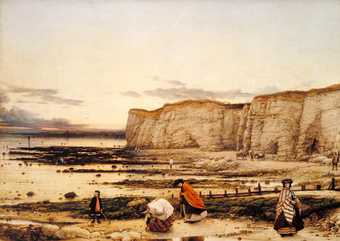
Fig.1
William Dyce
Pegwell Bay, Kent – a Recollection of October 5th 1858 ?1858–60
Tate N01407
At first sight, William Dyce’s Pegwell Bay, Kent – a Recollection of October 5th 1858 ?1858–60 (Tate N01407; fig.1) shows a typical Victorian beach scene. Three women in bulky clothes gather shells against a backdrop of minutely painted chalk cliffs. The time is sunset, and the glowing sky is reflected in the sea and rock pools. A small boy accompanies the women, holding a spade and looking out to sea. Additional figures are visible in the distance. Two of them, silhouetted against the bright water, are carrying shrimping nets; close to the cliff two further women are bending over and picking up shells; in front of them, a man in boots walks towards us, a bag in his hand. Another woman and a little girl appear to be exploring the rock pools as the tide recedes. Three donkeys with their two attendants wait on the shore. On the far right of the painting a man with a portfolio and perhaps a telescope under his arm turns away from us and gazes up at the sky. Only when we follow his gaze do we see the event which gives the painting its unusual and enigmatic title: the appearance of Donati’s comet, gradually becoming visible as the sun’s light diminishes.
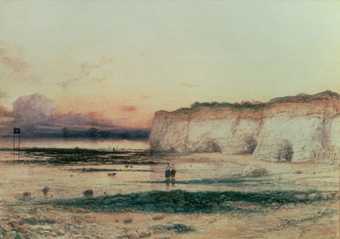
Fig.2
William Dyce
Study for Pegwell Bay, Kent – a Recollection of October 5th 1858 1857 or 1858
Aberdeen Art Gallery and Museums, Aberdeen
© Aberdeen Art Gallery and Museums Collections
Dyce (1806–1864) first exhibited this painting at the Royal Academy exhibition in 1860. It was shown again at the International Exhibition in London in 1862, and at the Exposition Universelle in Paris in 1867, after Dyce’s death. The only known preparatory study is a small watercolour (244 mm x 344 mm) with a date which has previously been read as 1857, but may in fact be 1858 (fig.2).1 The art critic James Dafforne declared in 1860: ‘The picture of “Pegwell Bay” was spoken of by many critical writers as having been painted from a photograph; and its wonderful elaborated detail favoured the supposition; we happen to know it was done from memory, aided by a slight and hasty sketch, in pencil, of the locality.’2 However, this pencil drawing has not survived, and the watercolour sketch shows the cliffs from a different angle.
The differences in the configuration of the cliffs between the watercolour and the oil painting, combined with Dafforne’s assertion that the painting was ‘done from memory’ and Dyce’s own description of it as a ‘recollection’, raise the question of its topographical accuracy. The painting of the cliffs has a meticulous degree of detail which makes it tempting to assume, as observers did at the time, that Dyce referred to a photograph. However, no photograph of Pegwell Bay from this angle appears to survive from the nineteenth century. Even allowing for the effects of erosion, and the changes to this location in the intervening 155 years, it is difficult to match either the watercolour or the oil with the cliffs as they appeared in 2015 (see the author’s photograph of the cliffs, fig.3). On the other hand, a visit to Pegwell Bay in October does show that Dyce observed the position of the setting sun accurately, and that his painting is true to the nature of the shore, with its mixture of chalk, seaweed, rock pools and sand. The shallow bay is greatly affected by the tide, which advances and recedes remarkably fast, leaving behind millions of shells (although today they are almost exclusively small mussel shells, rather than the varied types visible in the painting). Alexander Dyce, William Dyce’s cousin, writes about Pegwell Bay, in reminiscences dating from around 1867 to 1869, as ‘a scene now familiar to many who have never been there by the exquisite picture of my relative William Dyce, in which, however, he has rather embellished its features, and rather misrepresented the colour of its cliffs’.3 Alexander presumably meant that William had made the cliffs too grey rather than chalky white, and his comment that his cousin had ‘embellished’ the features of the location can only imply a belief that the forms of the cliffs in the painting were not topographically exact.
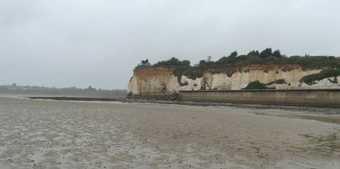
Fig.3
Pegwell Bay in 2015
© Christiana Payne 2015
William Dyce stayed in Ramsgate, close to Pegwell Bay, with his family in 1858. Apart from the watercolour, there is no corroborating evidence that he was also there in 1857, although he may have been. It was an easy excursion from London. The figures in the foreground have been identified from right to left as his wife, Jane, and her two sisters, Grace and Isabella Brand, with one of Dyce’s sons, presumably William, who was aged six in 1858. The figure looking up at the comet is likely to be the artist himself.4 The painting was sold to the artist’s father-in-law James Brand, who probably paid £400 for it. That is the implication of Dyce’s statement in a letter to his great friend and brother-in-law Robert Cay, written from North Wales in October 1860, where he says he and his family had been ‘rusticating’ for six weeks. The letter confirms that the family was in Ramsgate in 1858, but not in 1859, and suggests that Dyce treated these holidays as opportunities to produce small paintings which could easily be sold. He writes that Wales was proving better value than a seaside holiday in England, as they found lodgings for himself and his wife, two maids and four children for £8.4.0 a week, whereas in England
we cannot do it so cheap as that though we live in a dirty lodging – at any rate we got in Wales twice as much for the money as we ever did in England … These trips for a change of air always pay. I made £400 by my trip to Ramsgate two years ago and £620 by my last year’s trip to Arran, and I hope to make an equally good thing out of the Welsh excursion.5
This letter also provides supporting evidence that Dyce and his family would have been in Ramsgate in October, their usual time for holidays, and that he might well have witnessed Donati’s comet on 5 October 1858, on an excursion from his ‘dirty lodging’.
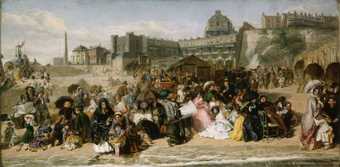
Fig.4
William Powell Frith
Ramsgate Sands: ‘Life at the Seaside’ 1854
Royal Collection, London
The women represented in the painting are shown wearing good quality, warm, sensible clothing rather than fashionable dress. The reviewers described them as wearing balmoral hats and linsey-woolsey petticoats. Balmoral hats are a traditional Scottish type of headgear; linsey-woolsey is woven with a cotton warp and woollen weft to produce a fabric that is fairly coarse and hard-wearing. In the mid-nineteenth century it was often associated with peasant costume. Although the different colours and stripes suggest that Dyce’s wife and sisters-in-law have put together their apparel with good taste and flair, they are very different from the women depicted in other Victorian paintings of seaside scenes. As William Powell Frith’s Ramsgate Sands: ‘Life at the Seaside’ of 1854 (fig.4) demonstrates, women in the 1850s used a day at the seaside as an opportunity to display their best silks and satins, accompanied by pretty bonnets, wide-brimmed straw hats, lacy shawls and parasols. Even the more modestly dressed woman in Arthur Boyd Houghton’s Ramsgate Sands of c.1861 (Tate N03907; fig.5) wears an elaborate bonnet, which shows off her curled hair and earring, complementing the fine material of her shawl and chequered dress. To a modern eye the women in Dyce’s painting look fantastically overdressed, but a contemporary observer might, on the contrary, have regarded them as modest and unadorned.
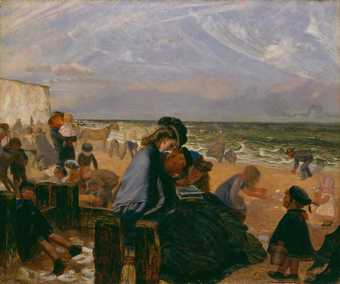
Fig.5
Arthur Boyd Houghton
Ramsgate Sands 1863
Tate N03907
Photo © Tate
Conservation reports show that the painting is in good condition and it has never had any major restoration work: it is likely, then, that its appearance has not changed over the century and a half since it was completed. Each detail is crisp and exact, including the foreground objects: the seaweed (of the type known as sea thong), a mermaid’s purse and the various shells. The colouring is fairly sombre, but the warm colours of the clothing of the foreground figures echo the colours of the sunset. The pink scarf worn by Dyce’s son, the red ‘shot silk’ effect on his wife’s shawl, and the orange of the central figure are all carefully and symmetrically placed to make a satisfying composition.
When he painted this picture, the Scottish-born Dyce was a successful and well-established artist. He had been a Royal Academician since 1848, and Professor of the Theory of Fine Arts at King’s College London since 1840. He had been given important commissions for frescoes in Queen Victoria’s seaside residence, Osborne House on the Isle of Wight, for the new church of All Saint’s, Margaret Street, and for the House of Lords.6 After a relatively late marriage in 1850, when he was forty-three and his wife only nineteen, Dyce had four children, two boys and two girls, between 1851 and 1855.
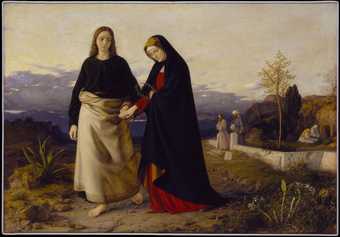
Fig.6
William Dyce
St John Leading Home his Adopted Mother 1842–60
Tate N01426
Photo © Tate
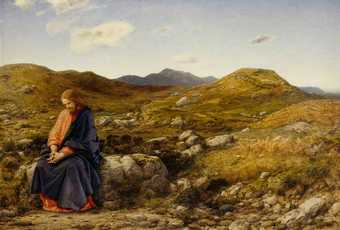
Fig.7
William Dyce
The Man of Sorrows c.1860
National Galleries of Scotland, Edinburgh
Pegwell Bay was one of three paintings shown by Dyce at the Royal Academy in London in 1860. The other two were St John Leading Home His Adopted Mother 1842–60 (Tate N01426; fig.6), which he described in the catalogue as ‘painted in 1844, revised 1851’ and The Man of Sorrows c.1860 (fig.7). Both of these religious subjects were set in landscapes. The stony foreground and exotic plants in St John are suggestive of the Holy Land.7 Christ as the man of sorrows, however, is sitting on a rock in what resembles a rough Scottish moorland, possibly the isle of Arran where Dyce and his family had spent their holiday in 1859. Dyce continued to produce religious paintings until the end of his life. His main exhibit at the Royal Academy in the following year, 1861, was a portrayal of the seventeenth-century poet and clergyman George Herbert, taking inspiration from nature in Herbert’s garden at Bemerton Rectory, near Salisbury (George Herbert at Bemerton c.1860, Guildhall Art Gallery, London).
By 1858 Dyce was in his early fifties. His fresco commissions meant that he had to work hard during the summer months, the only time when the English climate was sufficiently dry and warm for the purpose. As he explained in a letter to his great friend William Gladstone in August 1859, this work occupied him until ‘the turn of the season’, and after that he needed ‘country or seaside air’ until the end of October.8 London was an unhealthy place to live in the 1850s, and Dyce’s health was not good. In 1860, according to his son, he was unable to devote hardly any time to the frescoes in the Queen’s Robing Room in the Palace of Westminster owing to ‘the poor state of his health’;9 1861 was the last year in which he exhibited at the Royal Academy, and when he died in 1864, he had evidently been suffering for some time. Pegwell Bay was, perhaps, the recollection of one of his last carefree holidays, tinged with anxiety about an uncertain future.
